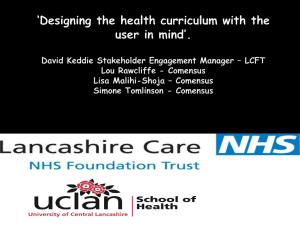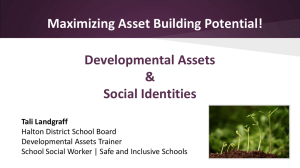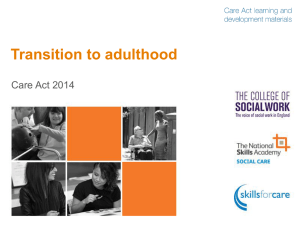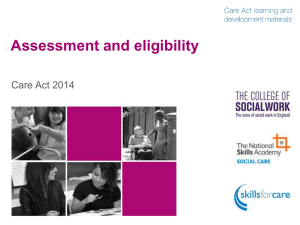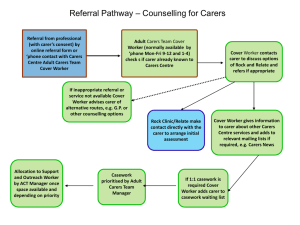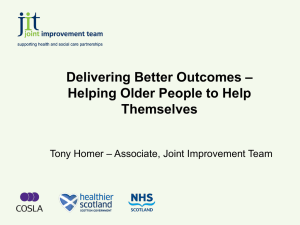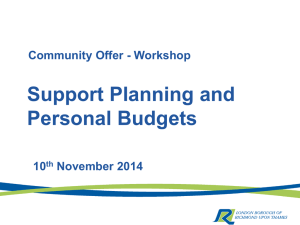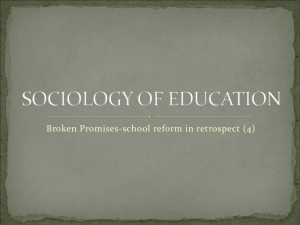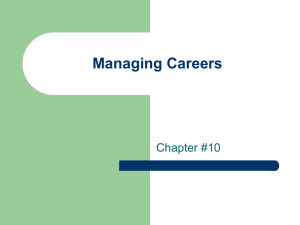Mon_Bayside106_1100_Goldfinch
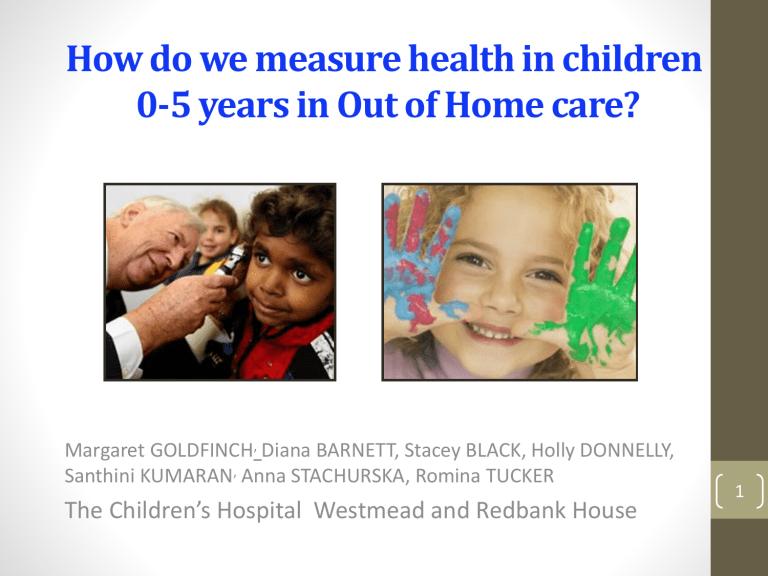
How do we measure health in children
0-5 years in Out of Home care?
Margaret GOLDFINCH , Diana BARNETT, Stacey BLACK, Holly DONNELLY,
Santhini KUMARAN , Anna STACHURSKA, Romina TUCKER
The Children’s Hospital Westmead and Redbank House
1
What health needs?
• Children in OOHC are a vulnerable “at-risk” group.
• This group are likely to have poorer physical, mental and developmental health than their peers. (RACP, 2006)
• 45% if all children in care in NSW in June 2010 were 0-6 years old.
2
• impacts on placement stability
,
(Horwitz et al, 2000; Rubin et al 2004)
• poor academic achievement
• increased risk of mental health problems in adolescence
• poor attachment in relationships as adults.
(Leslie et al, 2005)
3
National Clinical Assessment
Framework
(March 2011)
Physical
- Physical health history
- Physical examination and assessment
- Oral Health assessment
- Health literacy
Developmental
- Developmental history
- Speech, language and communication
- Motor development
- Cognitive development
- Sensory
Psychosocial and
Mental Health
- History
- Mental Health
- Behavioural
- Emotional development
- Social competence
- Development of identity
5
Why is this work so challenging?
• Children/P in OOHC have complex needs
• Change of placements/ carers
• Change of case workers
• Limited medical history
• Information lost/ not handed over
• No consistent advocate for the child
• Contact with birth parents
• Kinship/ relative carers- FOI issues
6
SCHN - OOHC clinic model
• Comprehensive Multidisciplinary assessments for 0- 5 year olds already in care.
• Model based on health, developmental and psychosocial needs identified in literature.
• Partnership between ACC, Redbank House and SCHN
(Randwick and Westmead)
• MD team- Paediatrician, Social Worker/Psychologist,
Audiologist, Orthoptist, SP, and OT. Senior Psychologist to provide supervision
7
OOHC Clinic Assessment
Background info:
• Caseworker makes health referral providing details of background, health information and reasons for entry into care
• Questionnaires sent to carers (ASQ3, ASQSE,
CBCL, SDQ, PSI-SF)
• Teachers- pre-school questionnaire (designed by clinic, four areas- motor performance, preacademic skills, language skills, social and behaviour)
8
0-5 yr old OOHC Clinic Assessment
Physical
Medical examination
Audiology Asst
Vision and eye screen
Psychosocial and
Mental Health
Play assessment
Interview with carer
Observation of child/ carer interaction/ relationship and attachment
Address any concerns raised by caseworker
Review preschool FB
Developmental
Developmental hx
ASQ3 review
Play assessment
Clinical observations during appointment
Formal assessment by
OT and/or Speech pathologist if indicated
Preschool quest’aire
9
Questionnaires
• ASQ3 (Ages and Stages 3)- parent completed, developmental screener, covers communication, gross motor, fine motor, problem-solving, personal-social
• CBCL (Child Behaviour Checklist)- assess a child’s behavioural, emotional and social problems and competencies from their parent or carers point of view
• PSI (Parenting Stress Index)- measures stress experienced by a carer in caring for a particular child, due to the specific features of the child or the nature of interactions with them
10
• ASQ SE (Ages & Stages Questionnaire –
Social/Emotional ) monitors a child’s development in the areas of self-regulation, compliance, communication, adaptive, autonomy, affect and interaction with people.
• SDQ (Strengths & Difficulties Questionnaire) - focuses on whether a child has difficulty with emotions, concentration, behaviour or getting along with others.
• Preschool/ School Questionnaire
11
Referral Information –
Search for
“Red Flags”
• Reasons for Removal
• Exposure to DV, abuse, AOD,
• Placement History
• Age at entry to care, number of placements, any placement breakdowns
• Medical history
• Genetic vulnerability, perinatal insults, neonatal abstinence syndrome, is child on medications
• Any Concerns from carer, child care, agencies
• Behaviour (tantrums, aggression),illness, developmental, social skills
• Inconsistencies between reports of child’s behaviour in different settings (eg carer and childcare)
12
Paediatric Assessment
Medical history
Sources of information :
• FaCS
(pre assessment - health questionnaire), blue book, ACIR, carer,
• Medical records
(neonatal and other discharge summaries, copy of medical letters)
,
• Reports
(AOD centre, psychologists, preschool)
Focus on: prenatal exposure to alcohol/ illicit drugs, prenatal exposure to Hepatitis B or C, perinatal complications, family history of developmental /intellectual disabilities, genetics, early growth parameters and how it change over time,immunization status, medications, allergies and current health concerns
Physical examination:
Focus on: growth, nutritional state, physical evidence of prenatal exposure to alcohol, dysmorphic features & thorough systemic examination ie. respiratory, cardiovascular, neurological, etc…
Allied health
• Audiology clinic: hearing testing
• Eye clinic: vision and eye screening
13
Psychosocial Assessment
• Any emotional or behavioral concerns? –eg tantrums, aggression, “spacing out”, sexualized behaviour, regulation problems
• Sleeping, eating, settling, comfort seeking, play, peer relations, sibling issues
• How these are managed by carer
• How does child relate within the foster family?
• Response to contact w biological family
• Developmental history (if available)
• Social and communication skills
• Review preschool feedback
14
Semi structured Play Assessment
Modified from Crowell Assessment (1988)
Approx 20 minutes
• Play as you normally would
• Follow child’s lead ( play skills collaboration, reciprocity, enjoyment)
• Ask child to pack up ( compliance , cooperation)
• Bubbles (enjoyment, collaboration)
• Puzzles (skills, attention, concentration, scaffolding, collaboration)
• Brief separation (3 mins)
• Reunion
• Reflection
15
Observations
Carer - sensitivity, structuring , intrusiveness, hostility
- Availability as a secure base
Child -responsiveness, involvement, initiative, regulation, cuing/miscuing carer, imagination
- Use of carer as a secure base
Dyad – comfort, tension and regulation, joint attention, reciprocity, enjoyment, mutuality
Multi D team Observations – developmental/play skills, fine motor, communication, multiple views of same behaviour or interaction -> rich discussion
16
Multi D Team Discussion
Medical Investigations/
Specialist referrals
Referral to
Speech or Occ
Therapy
HM
Report
Further Psych
Assessment or follow up support
Early Intervnention services
17
Steven
• 4 year old boy, removed at 24mths
• Two short term placements and has been in current placement for last 18 months
• Birth parents have intellectual disabilities, two siblings with developmental delay
18
• History of neglect , A & D during pregnancy and parental IV drug use (unknown Hep C status)
• Starting school next year, attends pre-school 3 days/week
• Pre-school worries about his learning, fine motor skills and outbursts of aggression towards peers
• Monthly contact with birth family. Carer reports difficulties with his behaviour before/after contact visit
19
Questionnaires :
• ASQ- III concerns in communication, fine motor, problem solving and personal social skills
• ASQ- SE and CBCL, SDQ- indicate problems with aggression, emotion regulation, concentration and sleep
20
Psychosocial
• Carer struggling with his behaviour at home
• Stephen has difficulty following directions (observed)
• Puzzle skills poor for his age. Carer not able to help him persist and had trouble encouraging him to pack up
• Quickly moved between play objects but didn’t persistently engage with any activity to developmental expectations
• Steven didn’t acknowledge return of carer after separation, or use her as a ”secure base” during the interview
21
Physical/ Medical
• No medical history prior to this placement
• Growth - 3 rd centile for height and weight (genetic? early neglect or organic ? no previous measurements)
• Mild facial dysmorphic features (no biological relatives to compare with)
• Dental decay
• Sleep difficulties- snores
• Hearing assessment: mild conductive hearing loss bilaterally
• Unremarkable rest of examination
22
Developmental
• Pre-school teacher indicated difficulties at preschool, poor fine motor skills and inability to follow instructions
• Clinic observations and screening questionnaires indicate need for formal developmental assessment
• Referred to OT and Speech Pathology within clinic
23
OT Assessment
• Completed M-FUN. Scores on fine motor component and visual motor component were below average.
• General observations showed some inattention during activities.
• Scattering of abilities and experience across different skills eg. Unable to cut along a line, poor drawing skills but aged appropriate self care skills
• Carer not having good knowledge of what is appropriate for their age
24
Speech Assessment
• Language skills assessed using the CELF-
Preschool-2.
• Difficulties with following directions accurately.
• Expressive language testing revealed reduced vocabulary and short length of utterance for age.
• Short attention span noted
25
Health Management Plan
(Recommendations)
• Continued stability in placement
• Support for carer around understanding and managing behavioural presentation
• OT &SP referral with Early Intervention
• Liaison with Department of Education and Communities (DEC) school planning
• Psychometric assessment prior to school
26
• ENT referral
• Routine oral health follow-up
• ?Genetics referral and investigation for DD
• Link with Paediatrician and GP - to monitor health, growth and developmental progress
• Caseworker to compile all health information and have access to this on file
27
Strengths of Multidisc Team
Assessment
• Combined interview :-
• More than one perspective on behaviour, symptoms or observations which appear contradictory in interview
• Allows medical assessment longer time frame
• Raises the profile of importance of developmental and psychosocial issues in health management of foster children
• Each clinician learns from other disciplines and improves assessment eg evolution of the play assessment
• Less clinic visits for carer and child
28
• Second occasion and location of assessment by OT & SP
• Picked up consistencies in child’s presentation and interaction w carer
• Subsequent team discussion
• richer and more balanced view of overlapping and complex symptoms and the child’s needs
• Combined HMP and Report
• Broader view of child’s wellbeing
• Greater access to/knowledge about services for follow-up
29
Difficulties we Encountered
• Some carers/families uncomfortable or suspicious of emotional or psychosocial assessment
• Large time allocation needed for collating information and writing comprehensive report
(considerable time)
• Single interview – sometimes needed time for discussion and reflection after interview before giving feedback
• Background history and information difficult to find due to fragmentation
• Different carers have different needs or expectations from the assessment process
30
Questions??
31
Reference:
Australian Institute of Health and Welfare (2010)
Chambers, M., Saunders, A., New, B. Williams, C. & Stachurska, A. (2010). Assessment of children coming into care: Processes, pitfalls and partnerships. Clinical Child Psychology
and Psychiatry. 15(4): 511-526.
Community Services Annual Report (2010)
Horwitz, S., Owens P., & Simms, M. (2000). Specialized assessments for children in foster care. Journal of Pediatrics. 106: 59–66.
Kaltner, M. & Rissel, K. (2011). Health of Australian children in out-of-home care: Needs and carer recognition. Journal of Paediatrics and Child Health. 47: 122-126.
Leslie, L., Gordon, J., Lambros, K., Premji, K., Peoples, J. & Gist K. (2005). Addressing the developmental and mental health needs of young children in foster care. Journal of
Developmental and Behavioral Pediatrics. 26: 40–51.
32
Nathanson, D. & Tzioumi, D. (2007). Health needs of Australian children living in out-ofhome-care. Journal of Paediatrics and Child Health. 43: 695-699.
Osborn, Alexandra and Delfabbro, Paul H. (2006) Research Article 4: An Analysis of the
Social Background and Placement History of Children with Multiple and Complex Needs in
Australian Out-of-home Care. Communities, Children and Families Australia. 1 (1): 33-42.
Rubin D, Alessandrini E, Feudtner C, Mandell D, Localio A & Hadley T. (2004). Placement stability and mental health costs for children in foster care. Journal of Pediatrics. 113:
1336–41.
Reynolds, S. (2008). Kari Clinic. KARI Aboriginal Resources Inc. SNAICC News
Tarren-Sweeney, M. & Hazell, P. (2006) Mental health of children in foster and kinship care in New South wales, Australia. Journal of Paediatrics and Child Health. 42: 89-97.
The Royal Australasian College of Physicians. (2006). Health of children in "out-of-home" care. 1-28.
Townsend, A. & Shelley, K. (2008). Validating an instrument for assessing workforce collaboration. Community College Journal of Research and Practice, 32 101-112.
33
